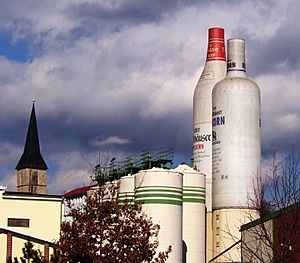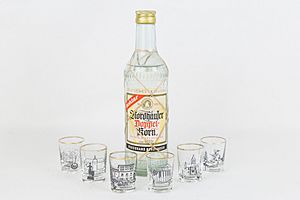Korn (liquor) facts for kids
Korn is a clear German drink. It is made from fermented grains like rye or wheat. You can also use barley, oats, and buckwheat. Most Korn is made from rye or wheat. Barley is mainly used to help the process.
Korn is different from vodka. It is not distilled as much and is filtered less. This means it keeps more of its grain flavor. No colors, flavors, or sweeteners are allowed in Korn.
Korn must have at least 32% alcohol. If it has more than 37.5% alcohol, it can be called Kornbrand. Doppelkorn is a type of Korn with 38% alcohol.
People often drink Korn plain in small glasses. It can also be mixed with a soft drink. In some places, people order a small glass of Korn with a beer. This mix is called a "Herrengedeck" in German. Some companies make fruit-flavored drinks using Korn. But these are sold as liqueurs, because Korn itself cannot have flavors added.
Very strong Korn is sometimes used to make homemade fruit or herb-flavored liqueurs. These are usually made weaker before they are bottled.
History of Korn
People believe Korn has been made in Germany since the 1400s. The first time Korn production was stopped was in 1545. The city of Nordhausen said that grain or malt could not be used to make spirits. Historians think beer makers wanted to stop competition from Korn producers. Making Korn was making grain more expensive.
The first "purity law" for Korn was made in 1789. This rule, set by the city of Nordhausen, said that Korn had to be made with two-thirds rye and one-third barley or malt.
How Korn is Made
Making Korn is similar to making other grain-based drinks like whisky. First, grains, usually wheat or rye, are ground up. Then they are cooked with hot water to make a thick mixture called a mash.
Next, the mixture is cooled down. Special barley malt or enzymes are added. These help turn the grain's starches into sugar. After that, the mash is cooled again and yeast is added. The yeast ferments the mixture, which creates alcohol.
Finally, the liquid goes through distillation many times. This removes unwanted smells and tastes. The strong liquid that comes out (about 85% alcohol) is then mixed with water. Some high-quality Korn is aged in oak barrels. This helps to make its taste smoother. Then it is made weaker to the right drinking strength and put into bottles.
Where Korn is Made in Germany
Korn is made in several parts of Germany. Some main areas include Bad Oldesloe and Nordhausen. It is also made in Haselünne and Oelde.
In Nordhausen, a company called Echter Nordhäuser Spirituosen GmbH makes a popular Korn brand called "Echter Nordhäuser." In 1799, the father of Otto von Bismarck started a Korn distillery.
Some of the most popular Korn brands in Germany are Oldesloer Weizenkorn and Strothmann Weizenkorn. For Doppelkorn, Echter Nordhäuser Doppelkorn is a leading brand.
See also
 In Spanish: Korn (licor) para niños
In Spanish: Korn (licor) para niños



